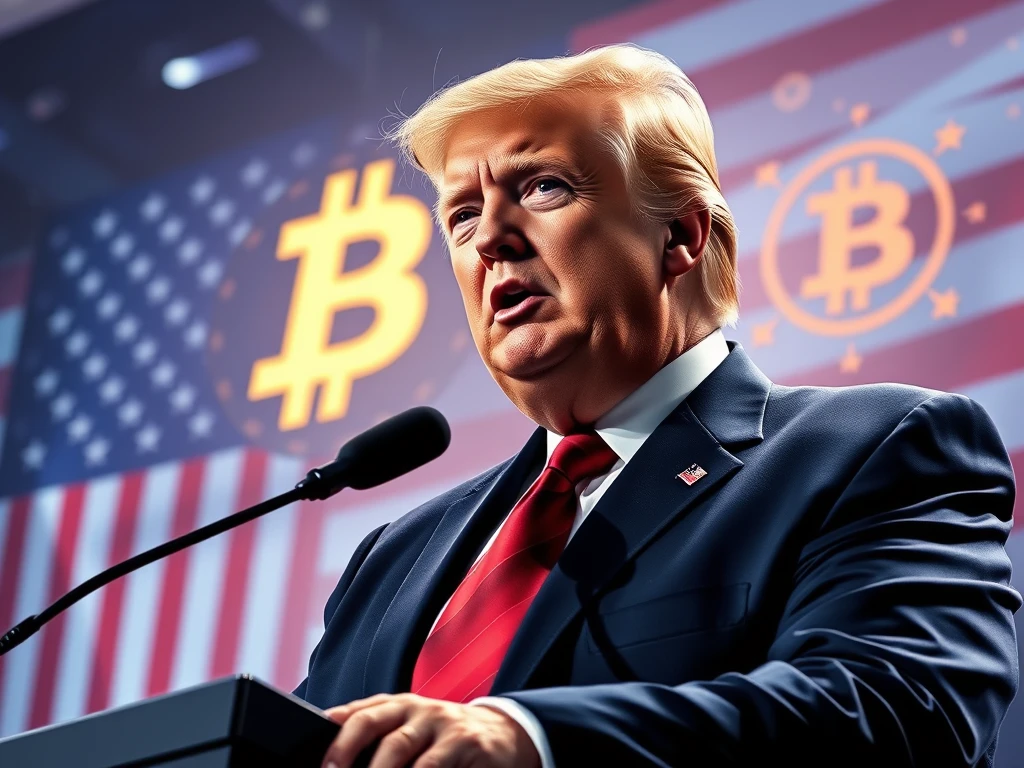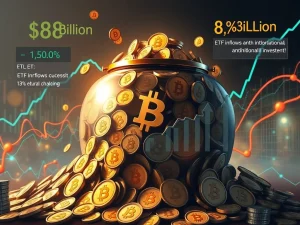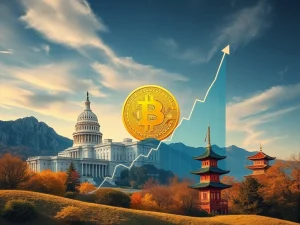Exclusive: Trump Shocks Crypto World as First US President to Speak at Major Summit

In a historic move that has sent ripples through the cryptocurrency world, Donald Trump has become the first sitting US president to directly address a major crypto conference. Speaking at the Blockworks Digital Asset Summit, Trump’s unprecedented appearance signals a significant shift in the US government’s engagement with the digital asset industry. This groundbreaking address underscores a growing recognition of crypto’s importance on the global stage and hints at potentially transformative policy changes under his administration.
Why is Trump’s Crypto Conference Address a Game Changer for US Crypto Regulation?
President Trump’s pre-recorded address to the Blockworks Digital Asset Summit on March 20th marks a pivotal moment. Never before has a sitting US president directly engaged with the crypto community at such a prominent event. This move is widely interpreted as a powerful signal of the Trump administration’s increasing embrace of the cryptocurrency sector. He emphasized his commitment to fostering an environment where the United States becomes the undisputed “crypto capital of the world.” This bold declaration suggests a proactive approach to US crypto regulation, contrasting with previous administrations perceived as more cautious or even resistant to digital assets.
Trump lauded the recent shifts in regulatory approaches, suggesting a more favorable landscape for crypto innovation under his leadership. He stated, “Pioneers like you will be able to improve our banking and payment system and promote greater privacy, safety, security and wealth for American consumers and businesses alike. You will unleash an explosion of economic growth.”
His remarks suggest a vision where cryptocurrencies are not just tolerated but actively encouraged as drivers of economic growth and technological advancement within the US. This represents a potentially seismic shift in the political narrative surrounding crypto in the United States.
Stablecoins and the US Dollar: Trump’s Vision for Global Financial Dominance
A key aspect of Trump’s address was his focus on stablecoins. He specifically highlighted the role of “dollar-backed stablecoins” in reinforcing the dominance of the US dollar for years to come. This statement reveals a strategic perspective where stablecoins are not just seen as another cryptocurrency, but as a tool to strengthen the US dollar’s global standing in the evolving digital financial landscape.
This perspective aligns with comments made by Treasury Secretary Scott Bessent at the White House Crypto Summit, where he touted stablecoins as a mechanism to ensure the US dollar remains the global reserve currency. The administration appears to be viewing stablecoins as a crucial component in maintaining America’s financial leadership in the face of growing global competition and the rise of digital currencies.
Further solidifying his administration’s pro-crypto stance, President Trump has already signed several executive orders aimed at integrating digital assets into the US financial system. These include:
- The Jan. 23rd Executive Order: Commissioning the Working Group on Digital Assets to develop a comprehensive strategy for digital asset regulation.
- Establishment of a Bitcoin Strategic Reserve and Crypto Stockpile: Indicating a forward-thinking approach to managing digital assets at a national level.
These actions, coupled with his digital asset summit address, paint a picture of an administration actively working to position the US at the forefront of the global crypto revolution.
President Trump addresses the Digital Asset Summit. Source: Crypto News Insights/Turner Wright
Decoding the White House Crypto Summit: Mixed Reactions and Future Expectations
Prior to the Blockworks Digital Asset Summit, President Trump hosted the inaugural White House Crypto Summit on March 7th. This event brought together key industry executives to discuss the future of crypto regulatory policy. While seen as a landmark event, the summit elicited mixed reactions from the crypto community.
Positive Perspectives:
- Institutional Investors and Executives: Largely viewed the summit as a positive step, recognizing the historical significance of the White House engaging directly with the crypto industry. They saw it as validation and a sign of growing legitimacy for digital assets.
- Net Positive Sentiment: The sheer fact of a White House summit dedicated to crypto was seen as a victory, indicating increased government attention and potential for more favorable regulations.
Underwhelming Reactions:
- Retail Investors and the Bitcoin Community: Many in the retail and Bitcoin-centric segments of the crypto community expressed disappointment. Some felt the summit lacked concrete outcomes or specific policy announcements.
- Concerns about Surveillance: Bitcoin maximalists, like Justin Bechler, voiced skepticism, viewing the summit as potentially promoting “state-approved surveillance tokens” rather than true decentralization.
The contrasting reactions highlight the diverse perspectives within the crypto space. While institutional players may welcome government engagement and regulation, some segments of the community remain wary of centralized control and potential overreach.
What’s Next for US Crypto Regulation Under Trump?
Despite the mixed reactions to the White House Crypto Summit, there are clear indications of forward momentum in US crypto regulation. Bo Hines, executive director of the Council of Advisers on Digital Assets, stated at the Blockworks Digital Asset Summit that a stablecoin bill is likely to be presented to President Trump within the next two months.
This timeline suggests a potentially rapid legislative push to establish a regulatory framework for stablecoins. Given the administration’s stated goal of solidifying the US dollar’s dominance and fostering crypto innovation, the coming months could be crucial for shaping the future of crypto in the United States.
Treasury Secretary Scott Bessent discusses stablecoin plans at the White House Crypto Summit. Source: The Associated Press
Bitcoin’s Price Reaction: A Sign of Things to Come?
Interestingly, the price of Bitcoin (BTC) experienced a 7.3% decline in the days following the White House Crypto Summit and the announcement of the Bitcoin strategic reserve order. This price action could be interpreted in several ways:
- Market Uncertainty: The mixed reactions to the summit might have introduced uncertainty into the market, leading to a temporary price correction.
- Strategic Reserve Limitations: The stipulation that the government could only acquire BTC through “budget-neutral strategies” might have tempered bullish expectations, as it suggested a potentially slow and limited accumulation of Bitcoin by the government.
- Broader Market Factors: It’s also important to consider that broader market trends and other external factors could have contributed to the Bitcoin price decline, independent of the summit and executive order announcements.
However, the long-term implications of President Trump’s pro-crypto stance and his administration’s regulatory initiatives remain overwhelmingly positive for the cryptocurrency industry. His direct engagement and stated commitment to making the US a crypto hub are unprecedented and could pave the way for significant growth and mainstream adoption of digital assets.
Conclusion: A New Era for Crypto in the United States?
Donald Trump’s address at the Blockworks Digital Asset Summit and his administration’s focus on US crypto regulation, particularly around stablecoins, signal a potentially transformative period for the cryptocurrency industry in the United States. While the White House crypto summit elicited mixed reactions, the overall trajectory points towards increasing government engagement and a more favorable regulatory environment. Whether this translates into the US truly becoming the “crypto capital of the world” remains to be seen, but the stage is undeniably set for a fascinating and potentially lucrative chapter in the evolution of digital assets under President Trump’s leadership.









